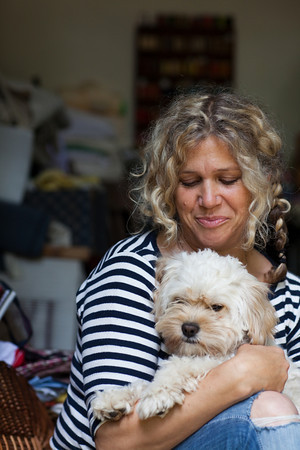It’s time to document the Fibershed wardrobe from the inside-out, and tell the story of the first garments— the ones that create a soft boundary between skin and those exterior clothes that protect us from the elements. The underwear as it is known, is like the interior of our homes—soft, plush, and comforting. There was no better seamstress cut-out for the work of creating these undergarments, than Molly de Vries.
On a visit to de Vries’s Mill Valley home and studio— we instantly fell in love with the place–it is a true family den, nurtured by a sensibility of beauty and an aesthetic steeped in ecological awareness. She grew up just yards away, in a similar size cottage that her mother still resides in to this day. De Vries’s home was historically utilized as a sleeping lodge– replete with cots and cozy blankets for visiting recreationists from San Francisco. It is now the ultimate enchanted bungalow for de Vries, her husband, three children, chickens, and dog.
Her home reflects her passion for the re-use of materials– from the original Redwood beams (harvested and milled on site at the turn of the last century), to the her eclectic assortment of vintage fabrics—de Vries is highly skilled at perceiving value, and imbuing function into once under appreciated artifacts.
“They don’t make materials like this anymore,’ she says as she picks up a stack of Romanian hemp fabrics. “These materials can last forever, but would decompose in the compost pile if they were tossed into one.’
She has recently ventured into a new project that weaves together her passion for ecology and the beauty of vintage cloth. “Our family is on a journey to a non-disposable life!” she said with excitement. “We are buying food in bulk, and shopping at the farmer’s markets and carrying our food in cloth sacks.” (known in Japan as Furoshiki.)
“The non-disposable life… is a process…. you can’t expect everyone in the family to be able to forgo plastics all at once, but you can make concerted steps in that direction,” de Vries says while modeling how her hand-sewn vintage carrying cloths wrap easily around a stainless steel food container. These Furoshiki wrapping cloths are designed to supplant the need for plastic bags, and can be used to wrap and carry produce and dry goods bought in bulk.
The Furoshiki tradition began in the 1300’s in Japan, (think origami styled fabric). The cloths were originally used to carry and contain clothes and material items for Japanese bathers, who made an art out of neatly packing their belongings while they waded in the wood-fire heated waters of the bathhouses. De Vries has discovered that these cloths are wonderfully useful for contemporary lifestyles, ‘you can make an art of carrying your food.. these cloths are perfect for taking prepared dishes to your friend’s house for dinner.’
De Vries is not only producing beautiful wares… but she produces them with total heart. Her business, Ambatalia Textiles for a Non-Disposable Life–is teaching women participants of the Canal Alliance to sew. “As the students learn, I hire them to work as seamstresses… these are very locally produced pieces.”
You can find these gorgeous textiles at the Marin County Farmer’s Market in Larkspur from 9am-2pm every Saturday. The importance of purchasing local food is a clear message, that is pretty well understood by us all. De Vries would like to carry the message a step further– and give her customers the ability to buy locally sewn textiles to artfully transport their beautiful food.
De Vries talent with the cloth and the machine is what brought us together. During our first conversation I was uplifted by her enthusiasm, ‘Fibershed is such a useful term, it’s what we can use to help people understand the importance of local production.’ She has been an ardent supporter of the project since its inception. Her ardency and commitment are the qualities that support her life as a mother of three, a business owner, and a seamstress for the Fibershed project. Some how, she gets it all done.
Underwear takes careful measuring… to do this correctly de Vries was immaculate in her note taking. We also had some amusing moments figuring out how to make these garments from a fabric that has no synthetic fibers… no lycra, no polyester, no acrylic. Just 100% color-grown organic cotton from the Capay Valley, (a one-hour drive).
We used an already constructed sample for the undie bottoms; the design was somewhere between a boy short, and a low-cut traditional women’s design.
We discussed busts… at great length…
It was decided that a tank top would function for both a bra, as well as a warm layer that would come in handy in the months ahead. (That tank was the best idea ever! As I am now happily wearing it as a base layer each and every day.)
For this photo, I forewent the goosebumps for a few moments so I could share de Vries exquisite handywork. The tank has hand-stitched details along every seam, and is made to last my lifetime, and then some…
Oh, and… (drum roll goes here)… the total transportation carbon footprint for this set of underwear.. (the tank and the bottoms together)…
.38 kg of C02
The weight of the garments .14 kg
What does this mean??
The closest comparison we could find in conventional clothing was in using Patagonia’s Carbon Chronicles. The company charted a pair of mens shorts through their whole carbon life-cycle, and derived that the amount of carbon released is equivalent to the weight of 8 pairs of those shorts.
In comparison..
It would take only 3 sets of our Fibershed undergarments to match the weight of carbon emitted.
This footprint is equivalent to driving your car .8 to 2.5 miles (the variation dependent on the fuel efficiency of your vehicle).
So, yes… these are numbers that make one’s heart sing. They are improvements on the journey towards a more harmonious wardrobe..
Thank you Molly de Vries for designing and sewing.. thank you Thara Srivinsin for the Carbon Calculations… thank you Sally Fox for the cotton, thank you Paige Green for the pictures… well done team!













